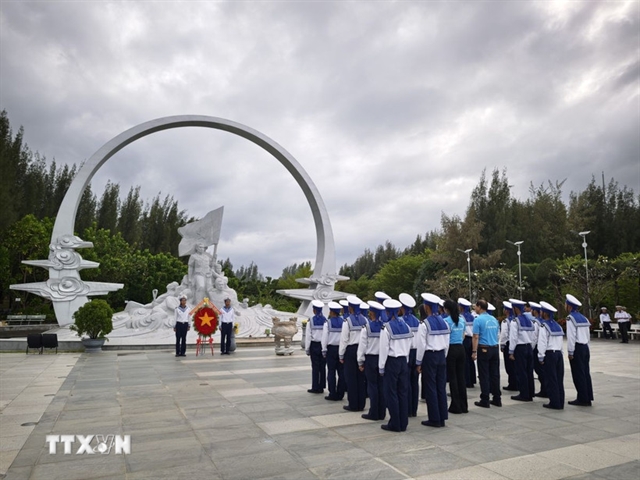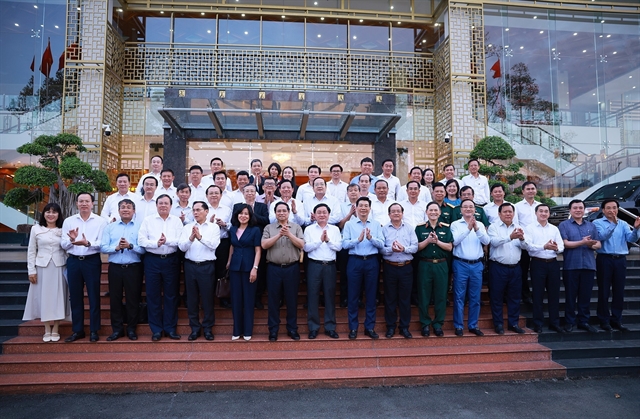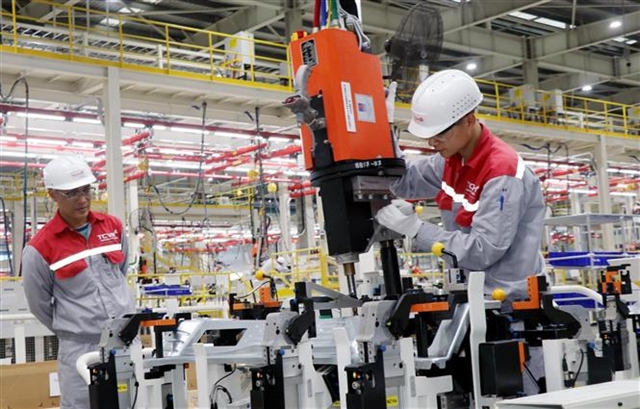 Society
Society

 |
| Giàng A La (fourth left) shows foreign tourists how to use the traditional musical instruments of the Mông people. — Photo courtesy of Giàng A La |
PHÚ THỌ — Hang Kia, located in the northern province of Phú Thọ, was once a hotspot for drugs. Now, the community is being revitalised thanks to the efforts of local authorities and residents.
One young Mông man stands out amid the area's transformation: Giàng A La, who has aspirations of prosperity for his homeland.
A La said that in 2018, after graduating from the Northwest College of Arts, he returned home with the desire to help his community build wealth on their native land.
Born and raised in a mountainous region full of hardships and shortages, A La understands better than anyone the difficult life of his parents and other local residents.
Initially, A La started his business breeding the well-known black chickens of the Mông people, a native bird that is considered to be medicinal and is famous for its nutritional value.
His initial capital was only VNĐ1 million (US$37), a gift awarded by his school for being the top graduate.
With this tiny seed fund, La built a small chicken coop, accumulating experience by teaching himself and experimenting with raising chickens.
But the path to entrepreneurship was not easy. A harsh climate, diseases and a lack of proper care techniques caused frequent losses to his flock.
After six years of persevering despite repeated losses, A La decided the chicken-raising model ultimately did not bring the expected profit.
Failures came quickly, one after another. But instead of giving up, A La considered them life lessons.
"Starting with nothing, I realised that to succeed, I must first acquire knowledge," he said.
Great potential
During his daily struggle to make a living, A La often helped tourist groups as a guide, performer or cook. Through these experiences, he recognised the vast potential of his homeland: pristine landscapes, unique Mông culture and local people’s hospitality.
From this realisation, a bold idea was born. A La shifted from chicken farming to developing community-based tourism combined with agriculture.
In the early days, with no capital, he borrowed money from his brothers and friends. Each person loaned him up to VNĐ10 million ($370), adding up to a total of VNĐ100 million ($3,700). With this initial capital, he built a homestay.
Unlike many places that rush to build concrete stilt houses with a faux-traditional look, A La chose to construct traditional Mông houses, ensuring cleanliness and only adding extra lighting for visitors.
It was this simplicity and authenticity that delighted tourists, who considered it a truly authentic experience.
He did not hide his difficulties.
“Coming late into the homestay movement, I had to find ways to differentiate my business from others. Whenever I had VNĐ10 million, I invested VNĐ10 million into the business. If I had VNĐ20 million, I used VNĐ20 million, and I was able to renovate gradually. Each year, I managed to save VNĐ100-200 million to reinvest,” he said.
Hang Kia’s transformation
 |
| Giàng A La on the brilliant purple sim flower hill in Hang Kia. — Photo courtesy of Giàng A La |
In 2020, Giàng A La and several other young people established the Hang Kia Tourism and Agricultural Cooperative.
This was the first model in the area to combine two fields: community-based tourism and local agricultural products.
His bold idea received strong support from local authorities, because of its sustainable direction in developing the local economy while also preserving cultural identity.
“The biggest investment is in people, knowledge and management thinking. As for the landscape, the village already has what it needs,” A La said.
Thanks to this philosophy, the cooperative quickly gathered many members, all working together to develop the area.
The cooperative was established just before the COVID-19 pandemic. Although the number of tourists dropped, they still made enough to maintain operations.
During the three years of the pandemic, A La didn't stop, but used the time to learn by participating in trainings and improving his management and marketing skills.
Today, visitors to Hang Kia can rest in traditional bamboo and wooden houses and immerse themselves in the daily life of the Mông people. They can participate in unique activities, such as pounding rice cakes, or enjoying ethnic cuisine featuring black chicken, local pork and corn wine.
A La said: “Visitors come here to find the unique identity of the Mông people, not something mixed or diluted. We keep the cultural story intact, from the houses and traditional costumes to the lifestyle. That is what truly fascinates the tourists.”
Beyond creating experiences, the cooperative also brings job opportunities for residents. Agricultural products, brocade and local specialties are introduced to tourists, generating additional income.
Mông women who used to only work in the fields now have a chance to work in tourism and handicraft sales. Instead of leaving the village to work far away, more young people are choosing to stay and work to develop tourism.
Giàng A La’s journey is not just a personal start-up story, but also a testament to the transformation of a land once labelled a hotspot for crime. From his failures with black chickens and hard struggles, the young man found a suitable path: building a business based on the cultural identity of his ethnic community.
His story also reflects the spirit of the National Target Programme for the development of ethnic groups and mountainous areas, encouraging ethnic youth to start businesses, develop the economy, preserve their culture and sustainably lower the poverty rate.
Today, when people mention Hang Kia, they think of a peaceful Mông village with authentic homestays, where visitors can immerse themselves in mountain scenery, a unique culture and the inspiring story of a young man who dared to dream and take action.
“What I want most is to create an environment where the younger generation has opportunities to study and work so they don’t have to leave their hometown. Getting rich right here on our homeland in a legitimate way, that is true happiness,” A La said.
Now, every step of the way, visitors feel a new vitality — the vitality of a community that knows how to unite, harness the potential for development and preserve their cultural identity to achieve sustainable prosperity. — VNS




